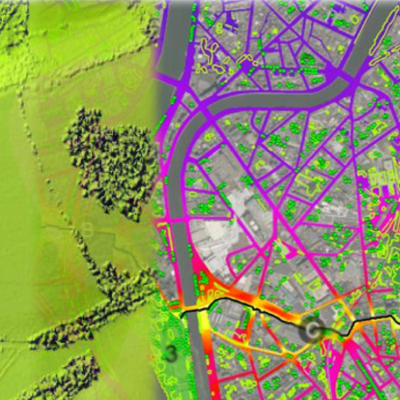Digital Twinning is a powerful informatics approach having applications across many disciplines, from engineering and aerospace to infrastructure and environment. Digital Twins or ‘DTs’, offer a systems-level overview of behaviours, responses and states of key selected system characteristics and can be used to help monitor, manage, maintain, optimise, extrapolate, predict system properties and behaviours and evaluate potential failure modes and sensitivity analyses.
Digital Twinning approaches are deeply embedded in the research, applied work, and teaching underway in Cranfield University and we have across the university a great depth of expertise and experience with these technologies. Below are some of the examples of DT work underway in Cranfield.
In practical use, Digital Twins can be used for example to develop advanced designs for complex engineering systems, such as gear assemblies or turbine engines. DTs can be used to develop and manage strategies for optimal flow of vehicular urban traffic, or the provision of water and sewerage services in real or near-real time. DTs can also be used to help understand, monitor and manage complex agricultural and environmental systems and ecological communities. These examples draw across several sectors but share many common characteristics.
Key to Digital Twinning approaches is the fusion of a range of data science and information technologies. The ability of DTs to capture system properties in real or near-real time is achieved using instrumented sensors and actuators able to determine selected system properties, for example water flow rates, temperature, CO₂ and light levels, traffic flow rates, mechanical position etc, and where appropriate the ability to make interventions, for example with automated gate valves, relay switches, and motorised assemblies.
The ‘Internet of Things’ (IoT) describes the collection of such ubiquitous physical devices, sensors and actuators, connected within high-speed data networks with resultant data being conditioned and made available for control systems and simulation modelling and AI tools. Data management and analytical approaches are used to interpret and synthesise system properties, allowing visualisation and presentational outputs to guide decision making.
Cranfield University research and teaching activities develop and utilise Digital Twinning approaches across many disciplines. Below are some examples of this work.
Case studies
The UKRI Urban Observatory
Part of the UKCRIC network, Cranfield University operates one of the nodes in the UKCRIC Urban Observatory network alongside other leading universities. The ‘Living Laboratory’ at Cranfield is a dense network of ubiquitous experimental sensors, capturing many aspects of campus life. Sensor networks monitor such things as lecture room occupancy and environmental conditions, levels of air quality adjacent to the airfield, stream runoff and drainage, water usage, soil conditions and biodiversity. Such data are used to research how DT approaches can be applied most effectively and with best practices. For more information https://www.livinglab.ac.uk
The ‘Data and Analytics for National Infrastructure’ facility DAFNI
Led by Oxford University and operated at STFC, the ‘Data and Analytics for National Infrastructure’ facility DAFNI, located in the Rutherford Appleton Laboratory site at Harwell, is the UK’s next generation platform to support the development of essential infrastructure services, revolutionising the UK’s ability to adapt to a changing climate and technological landscape. Cranfield University are Co-Investigators in this work and are deeply involved in its governance. DAFNI delivers compute capability, data access, specialised software tooling, and novel visualisation tools. For more information https://dafni.ac.uk



